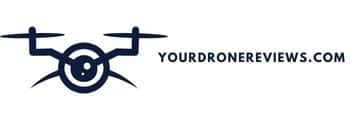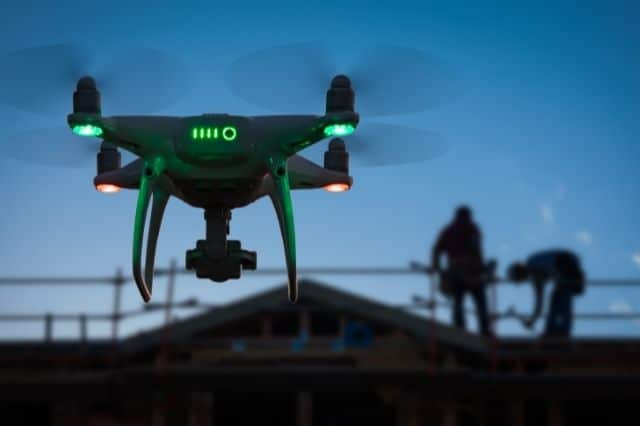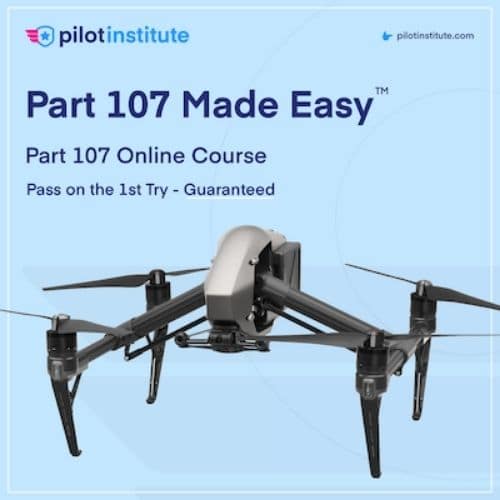Advances in drone technology have allowed them to be used for a variety of purposes, one of the most popular is for drone roof inspection. Roofing companies or building contractors can use drones to measure the size and shape of roofs, inspect for damage, detect any moisture etc.
Using drones for roof inspections can also be used by homeowners to regularly inspect their roofs and identify early warning signs of any kind of deterioration.
Drones provide a new and innovative way to thoroughly inspect roofs and there are a number of benefits of utilising drone technology over other inspection methods.
For anyone who is looking for a drone for roof inspections, the sheer number of high-quality drones that are now available can be overwhelming.
So, in this article I have narrowed down the list to 8, 3 of the drones are for commercial use and suitable building contractors and roofing companies, while the rest are suitable for regularly inspecting your roofs and making sure everything is okay.
The Benefits Of Using Drones For Roof Inspection
One of the main benefits of using drones for many commercial applications is that they provide a safer alternative to traditional methods of roof inspections.
Usually, to carry out a roof inspection, building contractors or roof installers would have to use put up temporary scaffolding or use a hydraulic lift. Although these are generally safe if they are installed and used properly, accidents do happen when people work from a great height.
Drones have emerged as a suitable option for roof inspections because they can fly up to the top of the building without any major safety risks to human lives. Drones are especially preferred in cases where it would be too risky or impractical for an inspector to go onto the rooftop, such as when there are dangerous objects on the rooftop or when there is high-voltage power equipment nearby.
Drones also provide easy access to areas that are hard to reach, some areas of a roof may be difficult to assess through traditional means. There may be obstructions, the area may be damaged and too dangerous for manual inspection.
Drones have flexible manoeuvrability and hovering capability that will allow operators to easily gain access to these areas and capture high-resolution videos and images which can be viewed live on a smartphone or tablet.
These images and videos can also be processed by a photogrammetry application for further details and analysis.
Another huge benefit is the overall reduction in time and cost of carrying out these inspections. Manual inspections require equipment like temporary scaffolding or some kind of portable lift to access roofs.
There is also the cost of labour, manual inspections will require more than one worker for safety reasons and the process is slow and laborious.
Companies are always looking to be more efficient and cut down costs while increasing overall ROI. Drones will allow them to do this as they will be able to carry out more inspection jobs while not compromising on data accuracy and improving the safety of their workers.
Many commercial drones either come with or can be fitted with thermal imaging cameras, these will help capture additional data that normal RGB cameras cannot pick up.
For example, areas with moisture or tiny gaps that can compromise effective insulation and cause serious damage can be easily picked up by a thermal imaging camera.
Regulations Regarding Using Drones For Commercial Applications
One final note before I list the most suitable drones for roof inspections is regarding the regulations on using drones for commercial applications.
In the USA, those who want to operate drones for commercial applications will need to obtain a Part 107 license from the FAA.
This will require them to pass a written examination at an FAA-approved testing centre, register their drone with the FAA and clearly label it with the registration number.
Although the FAA provide details for free training materials to help people prepare for the test, you may consider taking an online course to enhance your chances of passing the first time.
There are a lot of training courses to help pass the Part 107 test, one of the most popular is Pilot Institute, they have a money-back guarantee and a 99% success rate for students who complete the course.
However, there are also many others including highly rated courses on Udemy that you may also want to check out.
If you live in the UK, the rules are a little different, you no longer need specific permission from the CAA to fly for commercial purposes.
All drone pilots will need to obtain an operator ID and if the drone is above 250 grams, they will also require a Flyer ID.
There are three categories for drone use, they are open (which has three sub-categories), specific and certified.
Which category you fly in will depend on the weight of the drone and the level of risk associated with the drone mission.
You may need an operational authorisation from the CAA as roof inspections will fall into the specific category for commercial drone use.
For more details on the current drone regulations relating to commercial applications, read this excellent blog post from UAVHUB.
Best Drones For Roof Inspection
As I stated earlier in this article, there are a lot of drones that are equipped with high-resolution cameras that make them suitable for any kind of building inspection.
Any drones from DJI, Autel, Yuneec or Parrot can be used for roof inspections, even cheaper drones from the Hubsan Zino range are suitable for inspection purposes.
However, if you are a building contractor or a roofing company, I believe the best option is to get a drone that comes equipped with both a high-resolution camera and a thermal imaging camera.
There are a number of drones that can be fitted with multiple payloads, however, for roofing inspection, they are not very practical.
However, there are 5 very portable drones that come with an RGB and thermal camera and come with lots of advanced features such as intelligent flight modes, GPS modules and intelligent batteries for longer flight times.
All 5 drones have very similar features and have a foldable and lightweight design which makes them easy to travel around with.
#1) Parrot Anafi Thermal
One of the first commercial drones that came equipped with dual cameras, the Parrot Anafi thermal drone is an excellent choice for all types of building and infrastructure inspections. The Parrot Anafi Thermal drone has a 21MP 1/2.4-inch RGB sensor that can record 4k videos and has a 69° FOV. The infrared camera has FLIR Lepton 3.5 sensor that can accurately detect temperatures between -10° to +400°. The camera has a ±5°C accuracy rating and supports 3 colour palettes for better visual data under different environmental conditions. The drone comes with a couple of intelligent flight modes that will make conducting inspections easier and the data captured by the camera can be processed by a range of analytical tools from the likes of Pix4D, Drone Deploy and FLIR.
Parrot Anafi Thermal
#2) DJI Mavic 2 Enterprise Advanced
This DJI’s most advanced Mavic drone comes equipped with a 1/2-inch RGB sensor that can capture 48MP images, record 4k videos and has 32× digital zoom. The thermal imaging camera can record videos in 640×512 with a frame rate of 30Hz and has a temperature measurement accuracy of ±2°C. The drone also comes with an omnidirectional obstacle avoidance system, 30 minutes of flight time and an intelligent flight mode called waypoint that will allow operators to plan automated flight paths for easier inspection missions.
#3) Autel Evo 2 Dual 640T
This is an exceptional drone that is great for different types of building inspections. It has a dual camera that consists of an RGB camera with a 1/2-inch sensor and is capable of capturing high-resolution images in 48MP and recording 8k videos. The thermal imaging camera can record 640×512 videos at 30fps and has a temperature measurement accuracy level of ±3°C. The drone has a maximum flight time of 38 minutes and comes with a controller that has an integrated LCD screen for FPV and displays photo/video data. The drone comes with intelligent flight modes which include waypoint and image tracking.
#4) Parrot Anafi USA
The Parrot Anafi USA is the more advanced version of the Parrot Anafi Thermal and it has USA in its name because it has been approved by the Blue sUAS program. This is an industrial-grade drone that has an IP53 rating which will allow it to be operated in rain, windy and extremely cold conditions. Its similar in design to the Anafi Thermal, however, it is slightly bigger and weighs just over 500g, which is still very light for this type of drone. It has a multi-sensor payload that features a 21MP wide and telephoto camera as well as a high-resolution FLIR®BOSON infrared camera. Both the RGB camera and the telephoto camera can capture 4k videos and have a combined 32× zoom. The thermal camera has a <60mK rating and can detect temperature ranges between -10°C – 400°C. Other features the drone comes with includes 32 minutes of flight time 5km transmission range and several autonomous flight modes.
#5) DJI Matrice 30T
This is the most advanced drone on this list, if you are just doing roof inspections for residential houses, the Matrice 30T may be a little too sophisticated, however, if you have a drone inspection business and it involves inspecting large industrial sites and other high-value assets, the Matrice 30T should be considered. This is a powerful yet incredibly compact drone that has a foldable design and can easily be carried out in a backpack. The drone is equipped with a multi-sensor payload that includes a 4k, 12MP wide-angle camera, a 48MP, 4k zoom camera, a high-resolution thermal imaging camera and a laser rangefinder. There is also an FPV camera with night visons technology on top of the drone. The drone comes with an IP55 rating, so it can be operated in rain, windy and cold climates. It has several safety features including obstacle avoidance sensors, multiple redundancy systems, an ADS-B receiver and a failsafe automatic return to home feature. The drone comes with several autonomous flight modes, 41 minutes of flight time and a transmission range of 15km.
Drones For Roof Inspection Without Thermal Cameras
If you feel that you do not require a drone with thermal imaging capabilities but do want a drone with a high-resolution camera for detailed inspections, the following drones are a good choice.
This isn’t an exhaustive list, there are technically better drones, but for inspection purposes, they are more than capable.
They all cost less than $1000, with the DJI Mini SE being the most budget-friendly at under $300.
#1) DJI Mavic Air 2S
This is probably the best photography drone for under $1000, the DJI Mavic Air 2S comes equipped with a large 1-inch sensor that can capture amazing HDR images and videos. Images are captured in 20MP while videos can be recorded in 5.4k, 4k and 2.7k. The drone has a 4-way obstacle avoidance system and comes with several intelligent flight modes. It comes with a range of features that will allow operators to easily capture crystal clear images and videos. The drone has a maximum flight time of 30 minutes ad uses DJI’s innovative transmission technology for a smoother live video feed. There are two other drones in the Mavic Air range, they are the Mavic Air 2 and the original Mavic Air. Both are very good drones with excellent cameras, flight time and range, they are also cheaper.
#2) DJI Mavic 2 Pro/Zoom
The DJI Mavic 2 comes in two versions, the Mavic Pro and Zoom, the Pro version comes with a 1-inch Hasselblad camera while the Mavic Zoom has a 1/2.3-inch camera. The camera is the only major difference between these two drones, as everything else remains more or less the same. The Hasselblad camera can capture images in 20MP and comes with HDR support, while the Mavic Zoom can capture 48MP images with its super-resolution feature. The Zoom version also has 4× optical zoom that will be really useful for inspection purposes. Both drones can record video footage in true 4k, come with intelligent flight modes, an obstacle avoidance system and have 30 minutes of flight time.
#3) DJI Mini SE
The Mini SE is the best budget-friendly drone on this list, it has a very good camera that can capture 12MP still images and is stabilised by an advanced 3-axis gimbal for smoother videos and images. The drone weighs less than 250 grams, making it the lightest drone on this list but still holds up relatively well in mildly windy conditions. The drone does not come with waypoint intelligent flight mode so you cannot conduct automated inspection missions. It has 30 minutes of flight time and has a range of 4km.
#4) Parrot Anafi
Another very lightweight drone, the Parrot Anafi weighs just over 300 grams and comes with a 1/2.4-inch CMOS sensor that is stabilised by a hybrid 3-axis gimbal that can rotate 180° for some amazing viewing angles. The camera can capture 21MP images, 4k videos and comes with lossless digital zoom. The drone has a flight time of 25 minutes and comes with intelligent flight modes including waypoint and image tracking capability.
#5) Fimi X8 Mini
The X8 Mini drone is an exceptional mini drone that comes with some advanced features and weighs less than 250 grams. The drone is equipped with a 1/2.6-inch Sony sensor that can capture 12P images and 4k videos. The camera is stabilised by a 3-axis mechanical gimbal and comes with 3× digital zoom. The drone has a flight time of 30 minutes and has several automated flight modes.
Final Thoughts
Drones are becoming a popular tool for roof inspections because of the benefits outlined in this article, the most important being the safety they provide by eliminating the need to go up on rooftops. Drones provide accurate information about the state of roofs through high-resolution videos and images.





Minhaj, I do roof inspections for several roofing contractors, I’m 65 and not as comfortable on the steeper roofs, I figure for gutters and roof replacement, are there programs that figure roof squares? Rack edges, siding measurements ect, it seems like I could get a lot more done with a drone that offers these options, any advice what would work best for me?? Thankyou for your time
Hi Robert, sorry about the late reply, there are software applications that I think can do what you are asking, please check out Drone Deploy, specifically this page Roofing and the type of reports you can produce Roofing Report